Report on Managing Communication, Knowledge, and Information Systems
VerifiedAdded on 2020/01/28
|18
|5505
|44
Report
AI Summary
This report provides a comprehensive analysis of managing communication, knowledge, and information within a business context, specifically focusing on a startup food business aiming to expand. It explores various decision-making levels, including strategic, managerial, and tactical, and emphasizes the importance of acquiring relevant information and knowledge for effective decision-making. The report examines the assessment of both internal and external resources, including stakeholders such as employees, customers, suppliers, shareholders, and investors, and provides recommendations for improving communication strategies. It details the identification and engagement of stakeholders, along with the development of effective communication strategies. Furthermore, it evaluates existing communication procedures and suggests improvements, including the use of different communication processes and the development of personal skills. The report also assesses current approaches to information and knowledge management and proposes changes to enhance collection, formatting, storage, and dissemination, ultimately aiming to improve access to information systems and knowledge within the organization.
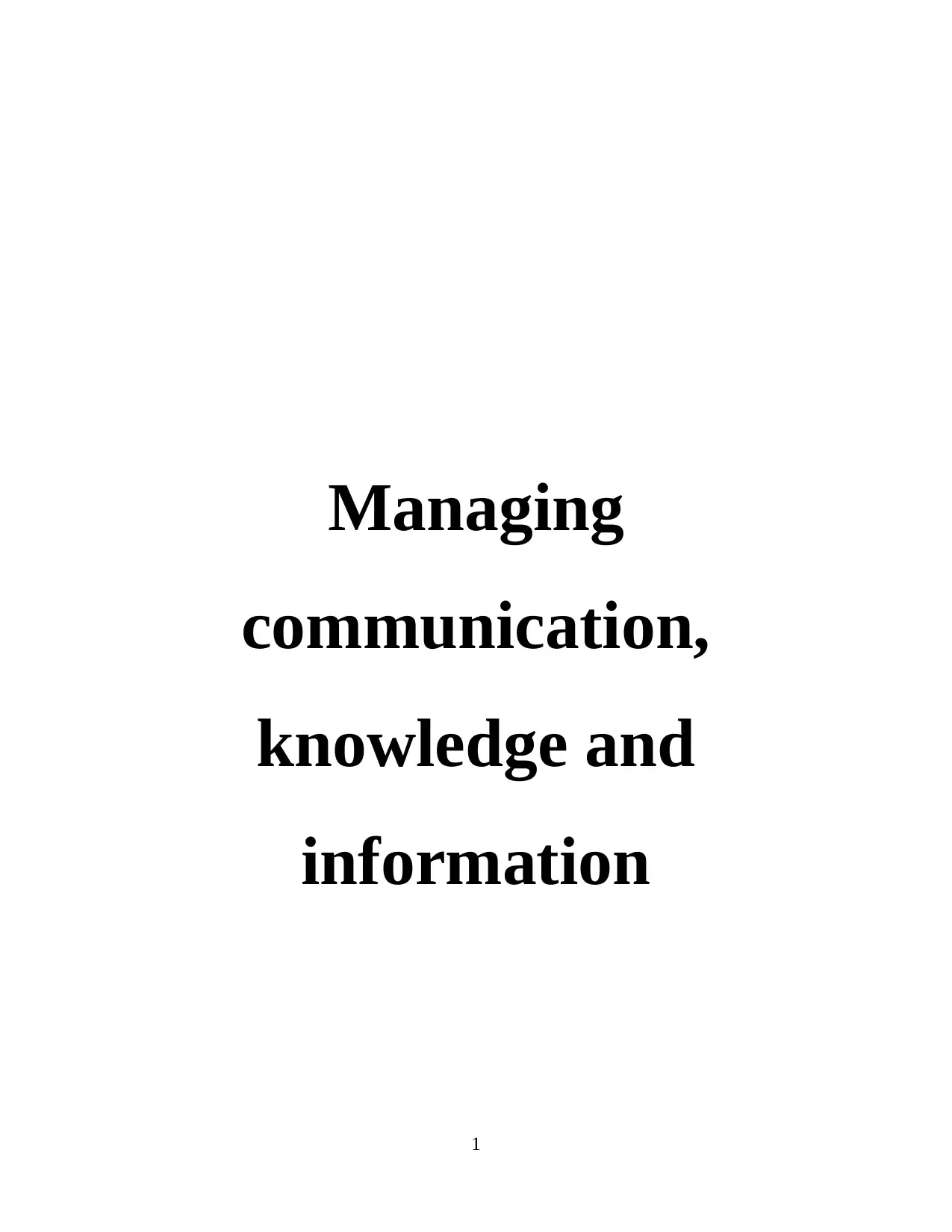
Managing
communication,
knowledge and
information
1
communication,
knowledge and
information
1
Paraphrase This Document
Need a fresh take? Get an instant paraphrase of this document with our AI Paraphraser
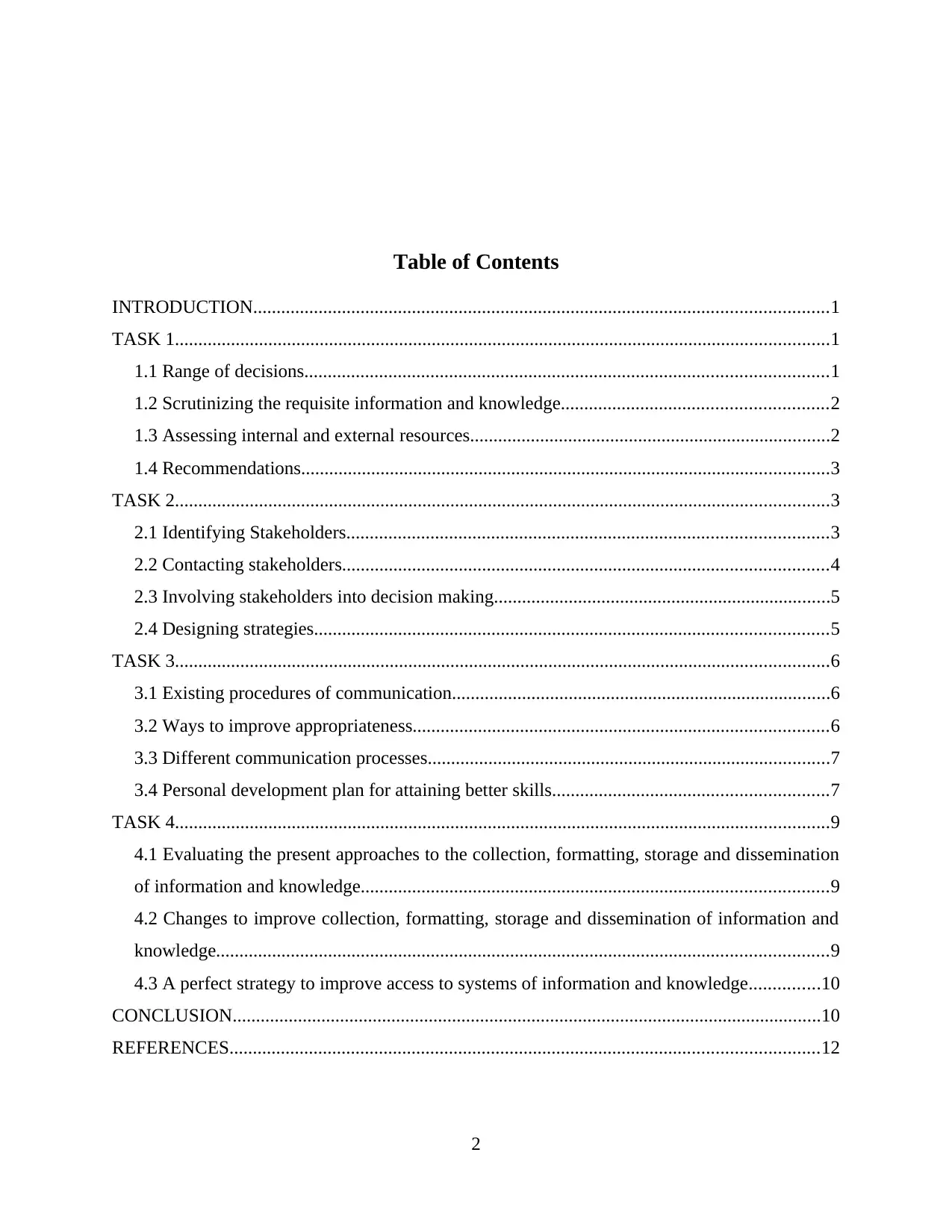
Table of Contents
INTRODUCTION...........................................................................................................................1
TASK 1............................................................................................................................................1
1.1 Range of decisions................................................................................................................1
1.2 Scrutinizing the requisite information and knowledge.........................................................2
1.3 Assessing internal and external resources.............................................................................2
1.4 Recommendations.................................................................................................................3
TASK 2............................................................................................................................................3
2.1 Identifying Stakeholders.......................................................................................................3
2.2 Contacting stakeholders........................................................................................................4
2.3 Involving stakeholders into decision making........................................................................5
2.4 Designing strategies..............................................................................................................5
TASK 3............................................................................................................................................6
3.1 Existing procedures of communication.................................................................................6
3.2 Ways to improve appropriateness.........................................................................................6
3.3 Different communication processes......................................................................................7
3.4 Personal development plan for attaining better skills...........................................................7
TASK 4............................................................................................................................................9
4.1 Evaluating the present approaches to the collection, formatting, storage and dissemination
of information and knowledge....................................................................................................9
4.2 Changes to improve collection, formatting, storage and dissemination of information and
knowledge...................................................................................................................................9
4.3 A perfect strategy to improve access to systems of information and knowledge...............10
CONCLUSION..............................................................................................................................10
REFERENCES..............................................................................................................................12
2
INTRODUCTION...........................................................................................................................1
TASK 1............................................................................................................................................1
1.1 Range of decisions................................................................................................................1
1.2 Scrutinizing the requisite information and knowledge.........................................................2
1.3 Assessing internal and external resources.............................................................................2
1.4 Recommendations.................................................................................................................3
TASK 2............................................................................................................................................3
2.1 Identifying Stakeholders.......................................................................................................3
2.2 Contacting stakeholders........................................................................................................4
2.3 Involving stakeholders into decision making........................................................................5
2.4 Designing strategies..............................................................................................................5
TASK 3............................................................................................................................................6
3.1 Existing procedures of communication.................................................................................6
3.2 Ways to improve appropriateness.........................................................................................6
3.3 Different communication processes......................................................................................7
3.4 Personal development plan for attaining better skills...........................................................7
TASK 4............................................................................................................................................9
4.1 Evaluating the present approaches to the collection, formatting, storage and dissemination
of information and knowledge....................................................................................................9
4.2 Changes to improve collection, formatting, storage and dissemination of information and
knowledge...................................................................................................................................9
4.3 A perfect strategy to improve access to systems of information and knowledge...............10
CONCLUSION..............................................................................................................................10
REFERENCES..............................................................................................................................12
2
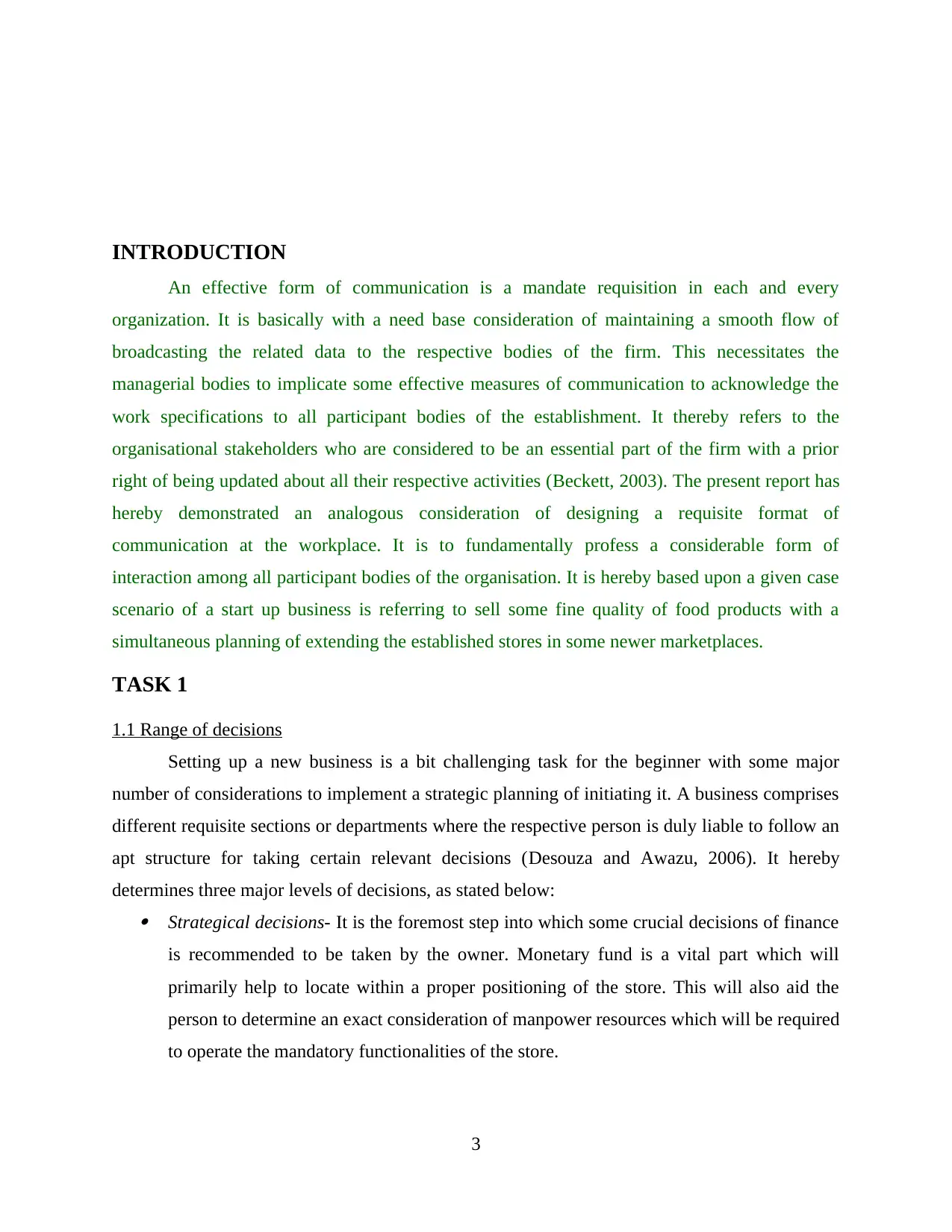
INTRODUCTION
An effective form of communication is a mandate requisition in each and every
organization. It is basically with a need base consideration of maintaining a smooth flow of
broadcasting the related data to the respective bodies of the firm. This necessitates the
managerial bodies to implicate some effective measures of communication to acknowledge the
work specifications to all participant bodies of the establishment. It thereby refers to the
organisational stakeholders who are considered to be an essential part of the firm with a prior
right of being updated about all their respective activities (Beckett, 2003). The present report has
hereby demonstrated an analogous consideration of designing a requisite format of
communication at the workplace. It is to fundamentally profess a considerable form of
interaction among all participant bodies of the organisation. It is hereby based upon a given case
scenario of a start up business is referring to sell some fine quality of food products with a
simultaneous planning of extending the established stores in some newer marketplaces.
TASK 1
1.1 Range of decisions
Setting up a new business is a bit challenging task for the beginner with some major
number of considerations to implement a strategic planning of initiating it. A business comprises
different requisite sections or departments where the respective person is duly liable to follow an
apt structure for taking certain relevant decisions (Desouza and Awazu, 2006). It hereby
determines three major levels of decisions, as stated below: Strategical decisions- It is the foremost step into which some crucial decisions of finance
is recommended to be taken by the owner. Monetary fund is a vital part which will
primarily help to locate within a proper positioning of the store. This will also aid the
person to determine an exact consideration of manpower resources which will be required
to operate the mandatory functionalities of the store.
3
An effective form of communication is a mandate requisition in each and every
organization. It is basically with a need base consideration of maintaining a smooth flow of
broadcasting the related data to the respective bodies of the firm. This necessitates the
managerial bodies to implicate some effective measures of communication to acknowledge the
work specifications to all participant bodies of the establishment. It thereby refers to the
organisational stakeholders who are considered to be an essential part of the firm with a prior
right of being updated about all their respective activities (Beckett, 2003). The present report has
hereby demonstrated an analogous consideration of designing a requisite format of
communication at the workplace. It is to fundamentally profess a considerable form of
interaction among all participant bodies of the organisation. It is hereby based upon a given case
scenario of a start up business is referring to sell some fine quality of food products with a
simultaneous planning of extending the established stores in some newer marketplaces.
TASK 1
1.1 Range of decisions
Setting up a new business is a bit challenging task for the beginner with some major
number of considerations to implement a strategic planning of initiating it. A business comprises
different requisite sections or departments where the respective person is duly liable to follow an
apt structure for taking certain relevant decisions (Desouza and Awazu, 2006). It hereby
determines three major levels of decisions, as stated below: Strategical decisions- It is the foremost step into which some crucial decisions of finance
is recommended to be taken by the owner. Monetary fund is a vital part which will
primarily help to locate within a proper positioning of the store. This will also aid the
person to determine an exact consideration of manpower resources which will be required
to operate the mandatory functionalities of the store.
3
⊘ This is a preview!⊘
Do you want full access?
Subscribe today to unlock all pages.

Trusted by 1+ million students worldwide
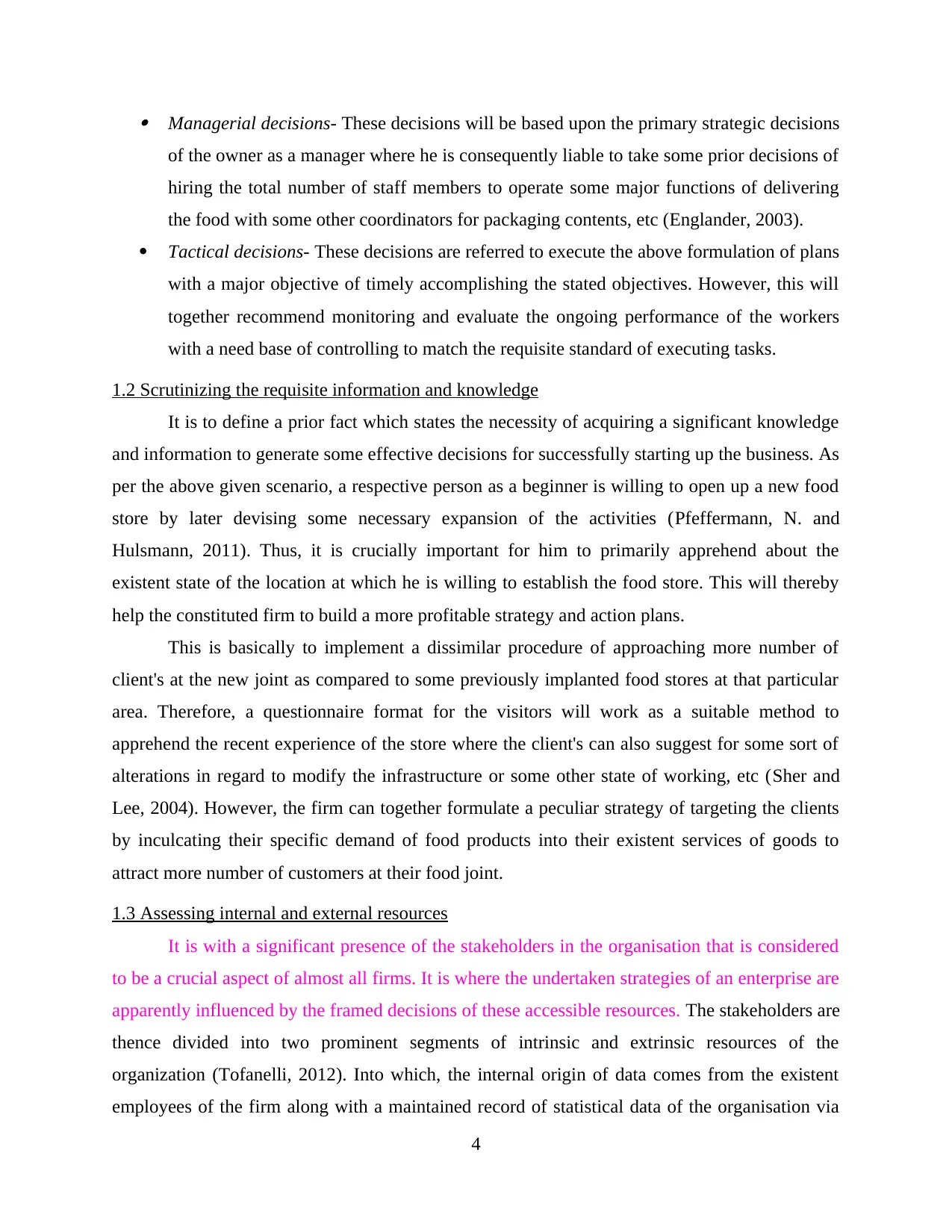
Managerial decisions- These decisions will be based upon the primary strategic decisions
of the owner as a manager where he is consequently liable to take some prior decisions of
hiring the total number of staff members to operate some major functions of delivering
the food with some other coordinators for packaging contents, etc (Englander, 2003).
Tactical decisions- These decisions are referred to execute the above formulation of plans
with a major objective of timely accomplishing the stated objectives. However, this will
together recommend monitoring and evaluate the ongoing performance of the workers
with a need base of controlling to match the requisite standard of executing tasks.
1.2 Scrutinizing the requisite information and knowledge
It is to define a prior fact which states the necessity of acquiring a significant knowledge
and information to generate some effective decisions for successfully starting up the business. As
per the above given scenario, a respective person as a beginner is willing to open up a new food
store by later devising some necessary expansion of the activities (Pfeffermann, N. and
Hulsmann, 2011). Thus, it is crucially important for him to primarily apprehend about the
existent state of the location at which he is willing to establish the food store. This will thereby
help the constituted firm to build a more profitable strategy and action plans.
This is basically to implement a dissimilar procedure of approaching more number of
client's at the new joint as compared to some previously implanted food stores at that particular
area. Therefore, a questionnaire format for the visitors will work as a suitable method to
apprehend the recent experience of the store where the client's can also suggest for some sort of
alterations in regard to modify the infrastructure or some other state of working, etc (Sher and
Lee, 2004). However, the firm can together formulate a peculiar strategy of targeting the clients
by inculcating their specific demand of food products into their existent services of goods to
attract more number of customers at their food joint.
1.3 Assessing internal and external resources
It is with a significant presence of the stakeholders in the organisation that is considered
to be a crucial aspect of almost all firms. It is where the undertaken strategies of an enterprise are
apparently influenced by the framed decisions of these accessible resources. The stakeholders are
thence divided into two prominent segments of intrinsic and extrinsic resources of the
organization (Tofanelli, 2012). Into which, the internal origin of data comes from the existent
employees of the firm along with a maintained record of statistical data of the organisation via
4
of the owner as a manager where he is consequently liable to take some prior decisions of
hiring the total number of staff members to operate some major functions of delivering
the food with some other coordinators for packaging contents, etc (Englander, 2003).
Tactical decisions- These decisions are referred to execute the above formulation of plans
with a major objective of timely accomplishing the stated objectives. However, this will
together recommend monitoring and evaluate the ongoing performance of the workers
with a need base of controlling to match the requisite standard of executing tasks.
1.2 Scrutinizing the requisite information and knowledge
It is to define a prior fact which states the necessity of acquiring a significant knowledge
and information to generate some effective decisions for successfully starting up the business. As
per the above given scenario, a respective person as a beginner is willing to open up a new food
store by later devising some necessary expansion of the activities (Pfeffermann, N. and
Hulsmann, 2011). Thus, it is crucially important for him to primarily apprehend about the
existent state of the location at which he is willing to establish the food store. This will thereby
help the constituted firm to build a more profitable strategy and action plans.
This is basically to implement a dissimilar procedure of approaching more number of
client's at the new joint as compared to some previously implanted food stores at that particular
area. Therefore, a questionnaire format for the visitors will work as a suitable method to
apprehend the recent experience of the store where the client's can also suggest for some sort of
alterations in regard to modify the infrastructure or some other state of working, etc (Sher and
Lee, 2004). However, the firm can together formulate a peculiar strategy of targeting the clients
by inculcating their specific demand of food products into their existent services of goods to
attract more number of customers at their food joint.
1.3 Assessing internal and external resources
It is with a significant presence of the stakeholders in the organisation that is considered
to be a crucial aspect of almost all firms. It is where the undertaken strategies of an enterprise are
apparently influenced by the framed decisions of these accessible resources. The stakeholders are
thence divided into two prominent segments of intrinsic and extrinsic resources of the
organization (Tofanelli, 2012). Into which, the internal origin of data comes from the existent
employees of the firm along with a maintained record of statistical data of the organisation via
4
Paraphrase This Document
Need a fresh take? Get an instant paraphrase of this document with our AI Paraphraser
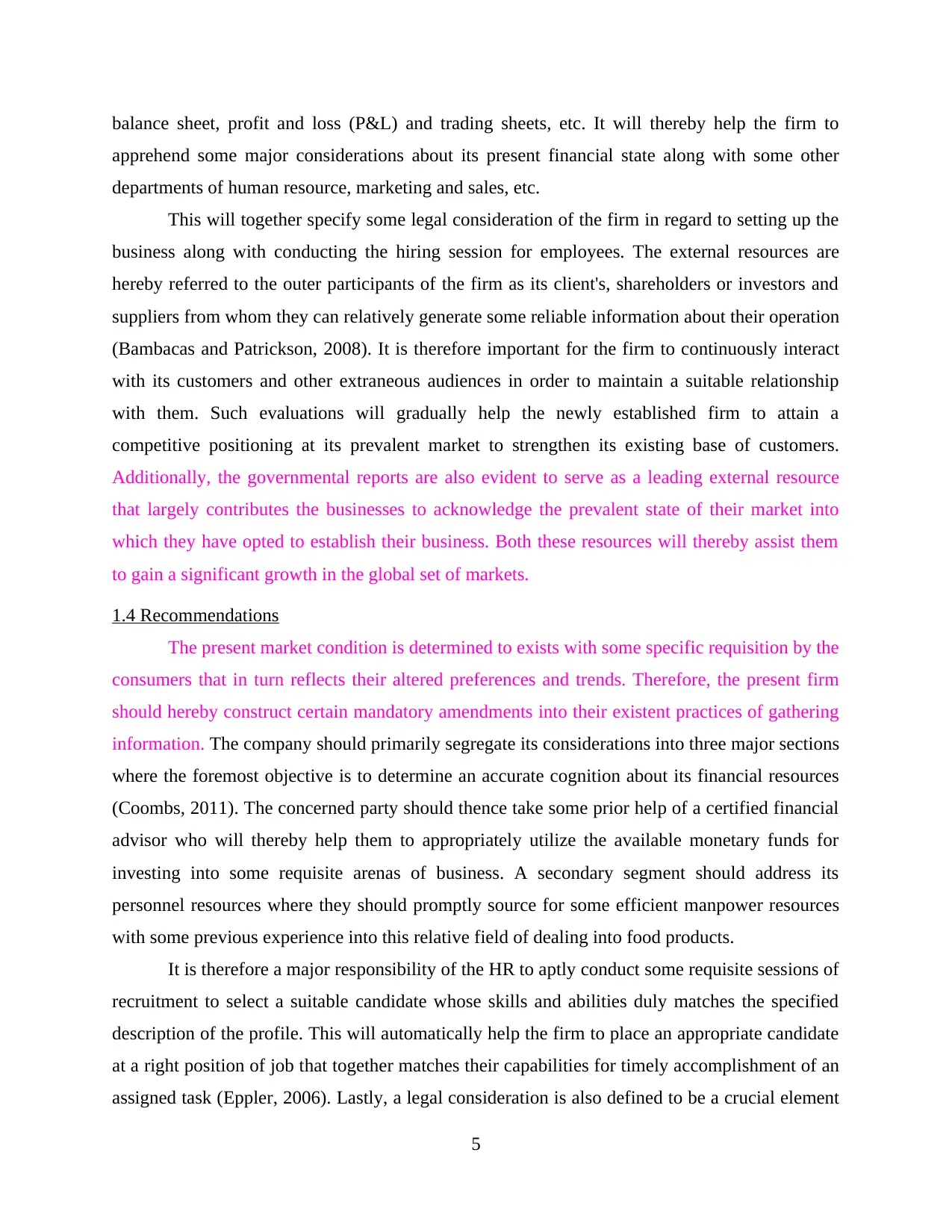
balance sheet, profit and loss (P&L) and trading sheets, etc. It will thereby help the firm to
apprehend some major considerations about its present financial state along with some other
departments of human resource, marketing and sales, etc.
This will together specify some legal consideration of the firm in regard to setting up the
business along with conducting the hiring session for employees. The external resources are
hereby referred to the outer participants of the firm as its client's, shareholders or investors and
suppliers from whom they can relatively generate some reliable information about their operation
(Bambacas and Patrickson, 2008). It is therefore important for the firm to continuously interact
with its customers and other extraneous audiences in order to maintain a suitable relationship
with them. Such evaluations will gradually help the newly established firm to attain a
competitive positioning at its prevalent market to strengthen its existing base of customers.
Additionally, the governmental reports are also evident to serve as a leading external resource
that largely contributes the businesses to acknowledge the prevalent state of their market into
which they have opted to establish their business. Both these resources will thereby assist them
to gain a significant growth in the global set of markets.
1.4 Recommendations
The present market condition is determined to exists with some specific requisition by the
consumers that in turn reflects their altered preferences and trends. Therefore, the present firm
should hereby construct certain mandatory amendments into their existent practices of gathering
information. The company should primarily segregate its considerations into three major sections
where the foremost objective is to determine an accurate cognition about its financial resources
(Coombs, 2011). The concerned party should thence take some prior help of a certified financial
advisor who will thereby help them to appropriately utilize the available monetary funds for
investing into some requisite arenas of business. A secondary segment should address its
personnel resources where they should promptly source for some efficient manpower resources
with some previous experience into this relative field of dealing into food products.
It is therefore a major responsibility of the HR to aptly conduct some requisite sessions of
recruitment to select a suitable candidate whose skills and abilities duly matches the specified
description of the profile. This will automatically help the firm to place an appropriate candidate
at a right position of job that together matches their capabilities for timely accomplishment of an
assigned task (Eppler, 2006). Lastly, a legal consideration is also defined to be a crucial element
5
apprehend some major considerations about its present financial state along with some other
departments of human resource, marketing and sales, etc.
This will together specify some legal consideration of the firm in regard to setting up the
business along with conducting the hiring session for employees. The external resources are
hereby referred to the outer participants of the firm as its client's, shareholders or investors and
suppliers from whom they can relatively generate some reliable information about their operation
(Bambacas and Patrickson, 2008). It is therefore important for the firm to continuously interact
with its customers and other extraneous audiences in order to maintain a suitable relationship
with them. Such evaluations will gradually help the newly established firm to attain a
competitive positioning at its prevalent market to strengthen its existing base of customers.
Additionally, the governmental reports are also evident to serve as a leading external resource
that largely contributes the businesses to acknowledge the prevalent state of their market into
which they have opted to establish their business. Both these resources will thereby assist them
to gain a significant growth in the global set of markets.
1.4 Recommendations
The present market condition is determined to exists with some specific requisition by the
consumers that in turn reflects their altered preferences and trends. Therefore, the present firm
should hereby construct certain mandatory amendments into their existent practices of gathering
information. The company should primarily segregate its considerations into three major sections
where the foremost objective is to determine an accurate cognition about its financial resources
(Coombs, 2011). The concerned party should thence take some prior help of a certified financial
advisor who will thereby help them to appropriately utilize the available monetary funds for
investing into some requisite arenas of business. A secondary segment should address its
personnel resources where they should promptly source for some efficient manpower resources
with some previous experience into this relative field of dealing into food products.
It is therefore a major responsibility of the HR to aptly conduct some requisite sessions of
recruitment to select a suitable candidate whose skills and abilities duly matches the specified
description of the profile. This will automatically help the firm to place an appropriate candidate
at a right position of job that together matches their capabilities for timely accomplishment of an
assigned task (Eppler, 2006). Lastly, a legal consideration is also defined to be a crucial element
5
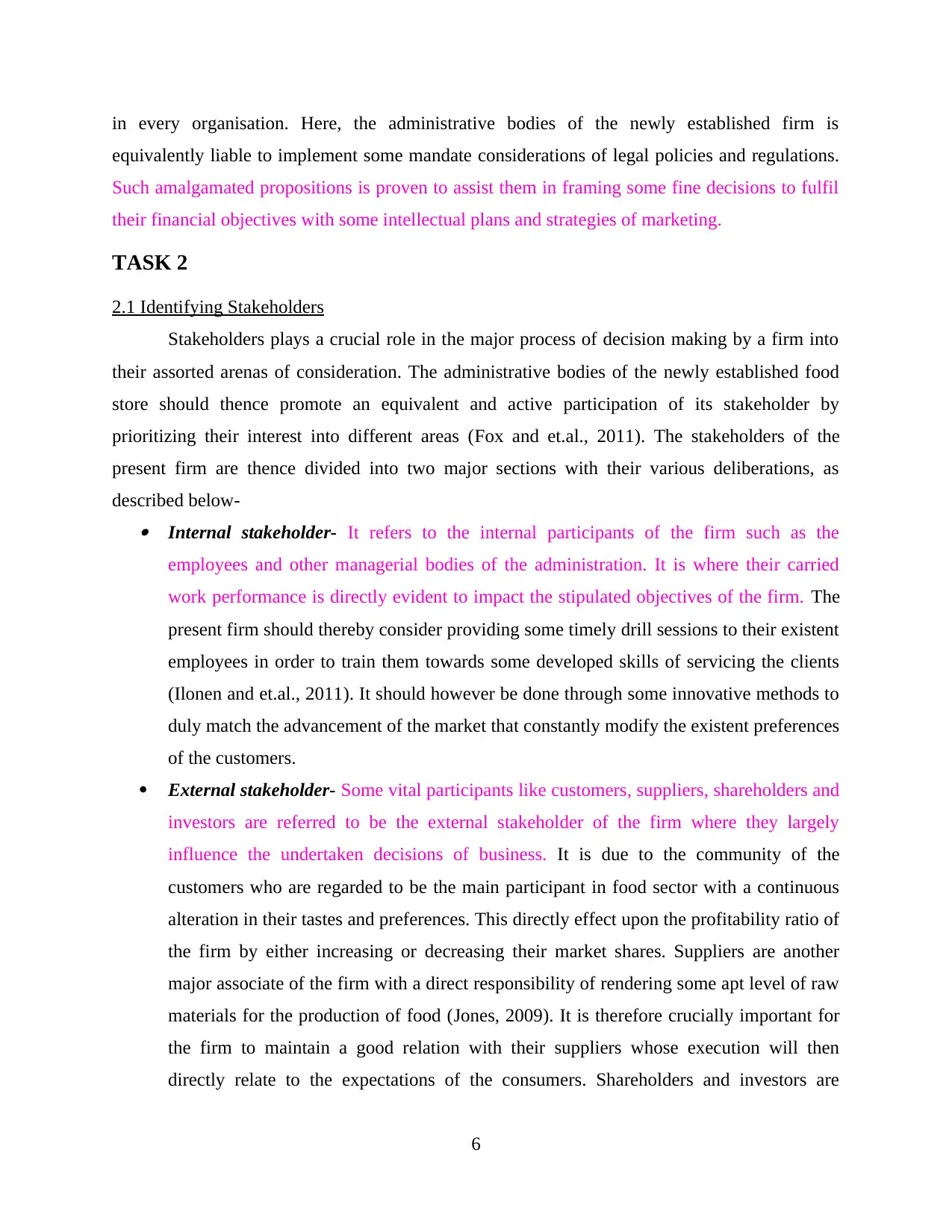
in every organisation. Here, the administrative bodies of the newly established firm is
equivalently liable to implement some mandate considerations of legal policies and regulations.
Such amalgamated propositions is proven to assist them in framing some fine decisions to fulfil
their financial objectives with some intellectual plans and strategies of marketing.
TASK 2
2.1 Identifying Stakeholders
Stakeholders plays a crucial role in the major process of decision making by a firm into
their assorted arenas of consideration. The administrative bodies of the newly established food
store should thence promote an equivalent and active participation of its stakeholder by
prioritizing their interest into different areas (Fox and et.al., 2011). The stakeholders of the
present firm are thence divided into two major sections with their various deliberations, as
described below- Internal stakeholder- It refers to the internal participants of the firm such as the
employees and other managerial bodies of the administration. It is where their carried
work performance is directly evident to impact the stipulated objectives of the firm. The
present firm should thereby consider providing some timely drill sessions to their existent
employees in order to train them towards some developed skills of servicing the clients
(Ilonen and et.al., 2011). It should however be done through some innovative methods to
duly match the advancement of the market that constantly modify the existent preferences
of the customers.
External stakeholder- Some vital participants like customers, suppliers, shareholders and
investors are referred to be the external stakeholder of the firm where they largely
influence the undertaken decisions of business. It is due to the community of the
customers who are regarded to be the main participant in food sector with a continuous
alteration in their tastes and preferences. This directly effect upon the profitability ratio of
the firm by either increasing or decreasing their market shares. Suppliers are another
major associate of the firm with a direct responsibility of rendering some apt level of raw
materials for the production of food (Jones, 2009). It is therefore crucially important for
the firm to maintain a good relation with their suppliers whose execution will then
directly relate to the expectations of the consumers. Shareholders and investors are
6
equivalently liable to implement some mandate considerations of legal policies and regulations.
Such amalgamated propositions is proven to assist them in framing some fine decisions to fulfil
their financial objectives with some intellectual plans and strategies of marketing.
TASK 2
2.1 Identifying Stakeholders
Stakeholders plays a crucial role in the major process of decision making by a firm into
their assorted arenas of consideration. The administrative bodies of the newly established food
store should thence promote an equivalent and active participation of its stakeholder by
prioritizing their interest into different areas (Fox and et.al., 2011). The stakeholders of the
present firm are thence divided into two major sections with their various deliberations, as
described below- Internal stakeholder- It refers to the internal participants of the firm such as the
employees and other managerial bodies of the administration. It is where their carried
work performance is directly evident to impact the stipulated objectives of the firm. The
present firm should thereby consider providing some timely drill sessions to their existent
employees in order to train them towards some developed skills of servicing the clients
(Ilonen and et.al., 2011). It should however be done through some innovative methods to
duly match the advancement of the market that constantly modify the existent preferences
of the customers.
External stakeholder- Some vital participants like customers, suppliers, shareholders and
investors are referred to be the external stakeholder of the firm where they largely
influence the undertaken decisions of business. It is due to the community of the
customers who are regarded to be the main participant in food sector with a continuous
alteration in their tastes and preferences. This directly effect upon the profitability ratio of
the firm by either increasing or decreasing their market shares. Suppliers are another
major associate of the firm with a direct responsibility of rendering some apt level of raw
materials for the production of food (Jones, 2009). It is therefore crucially important for
the firm to maintain a good relation with their suppliers whose execution will then
directly relate to the expectations of the consumers. Shareholders and investors are
6
⊘ This is a preview!⊘
Do you want full access?
Subscribe today to unlock all pages.

Trusted by 1+ million students worldwide
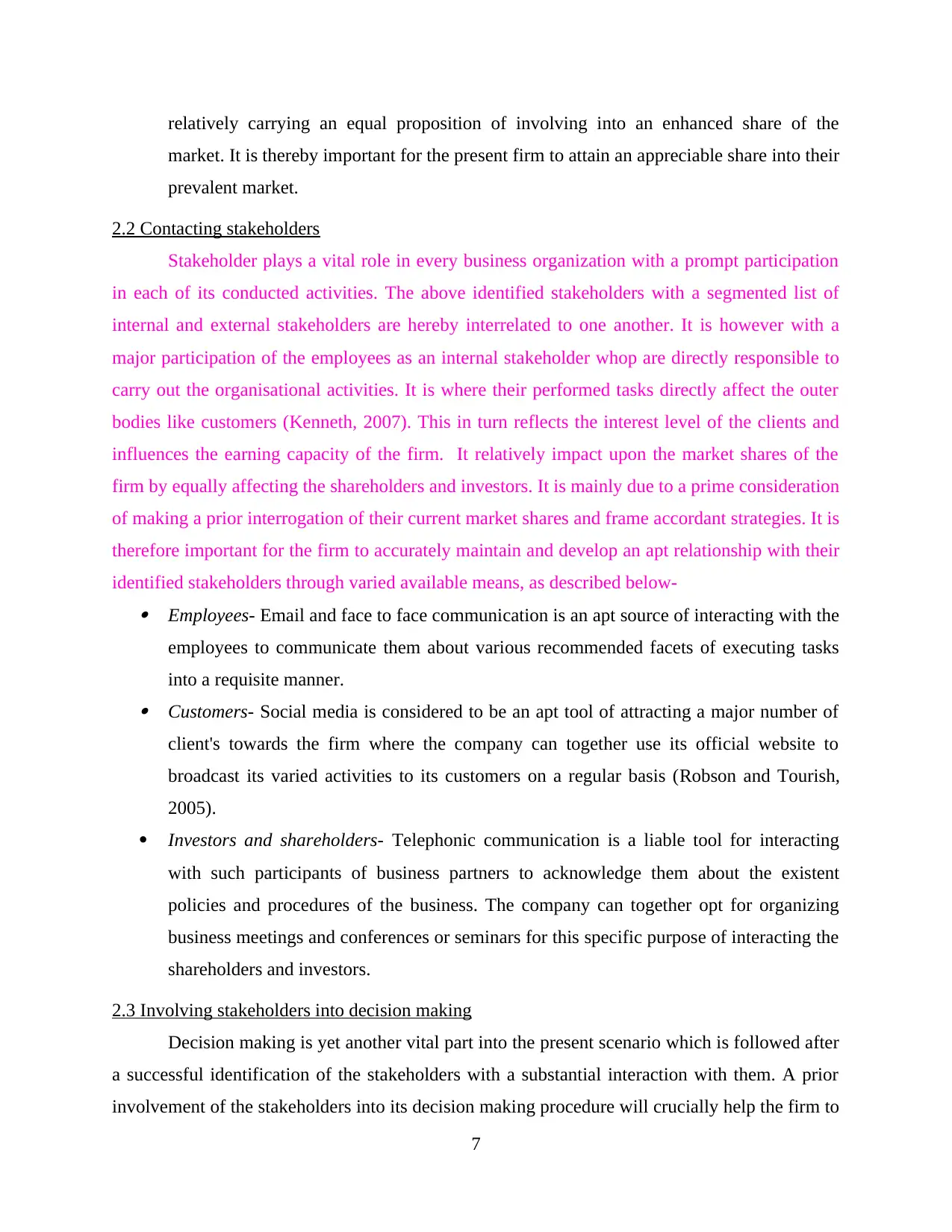
relatively carrying an equal proposition of involving into an enhanced share of the
market. It is thereby important for the present firm to attain an appreciable share into their
prevalent market.
2.2 Contacting stakeholders
Stakeholder plays a vital role in every business organization with a prompt participation
in each of its conducted activities. The above identified stakeholders with a segmented list of
internal and external stakeholders are hereby interrelated to one another. It is however with a
major participation of the employees as an internal stakeholder whop are directly responsible to
carry out the organisational activities. It is where their performed tasks directly affect the outer
bodies like customers (Kenneth, 2007). This in turn reflects the interest level of the clients and
influences the earning capacity of the firm. It relatively impact upon the market shares of the
firm by equally affecting the shareholders and investors. It is mainly due to a prime consideration
of making a prior interrogation of their current market shares and frame accordant strategies. It is
therefore important for the firm to accurately maintain and develop an apt relationship with their
identified stakeholders through varied available means, as described below- Employees- Email and face to face communication is an apt source of interacting with the
employees to communicate them about various recommended facets of executing tasks
into a requisite manner. Customers- Social media is considered to be an apt tool of attracting a major number of
client's towards the firm where the company can together use its official website to
broadcast its varied activities to its customers on a regular basis (Robson and Tourish,
2005).
Investors and shareholders- Telephonic communication is a liable tool for interacting
with such participants of business partners to acknowledge them about the existent
policies and procedures of the business. The company can together opt for organizing
business meetings and conferences or seminars for this specific purpose of interacting the
shareholders and investors.
2.3 Involving stakeholders into decision making
Decision making is yet another vital part into the present scenario which is followed after
a successful identification of the stakeholders with a substantial interaction with them. A prior
involvement of the stakeholders into its decision making procedure will crucially help the firm to
7
market. It is thereby important for the present firm to attain an appreciable share into their
prevalent market.
2.2 Contacting stakeholders
Stakeholder plays a vital role in every business organization with a prompt participation
in each of its conducted activities. The above identified stakeholders with a segmented list of
internal and external stakeholders are hereby interrelated to one another. It is however with a
major participation of the employees as an internal stakeholder whop are directly responsible to
carry out the organisational activities. It is where their performed tasks directly affect the outer
bodies like customers (Kenneth, 2007). This in turn reflects the interest level of the clients and
influences the earning capacity of the firm. It relatively impact upon the market shares of the
firm by equally affecting the shareholders and investors. It is mainly due to a prime consideration
of making a prior interrogation of their current market shares and frame accordant strategies. It is
therefore important for the firm to accurately maintain and develop an apt relationship with their
identified stakeholders through varied available means, as described below- Employees- Email and face to face communication is an apt source of interacting with the
employees to communicate them about various recommended facets of executing tasks
into a requisite manner. Customers- Social media is considered to be an apt tool of attracting a major number of
client's towards the firm where the company can together use its official website to
broadcast its varied activities to its customers on a regular basis (Robson and Tourish,
2005).
Investors and shareholders- Telephonic communication is a liable tool for interacting
with such participants of business partners to acknowledge them about the existent
policies and procedures of the business. The company can together opt for organizing
business meetings and conferences or seminars for this specific purpose of interacting the
shareholders and investors.
2.3 Involving stakeholders into decision making
Decision making is yet another vital part into the present scenario which is followed after
a successful identification of the stakeholders with a substantial interaction with them. A prior
involvement of the stakeholders into its decision making procedure will crucially help the firm to
7
Paraphrase This Document
Need a fresh take? Get an instant paraphrase of this document with our AI Paraphraser
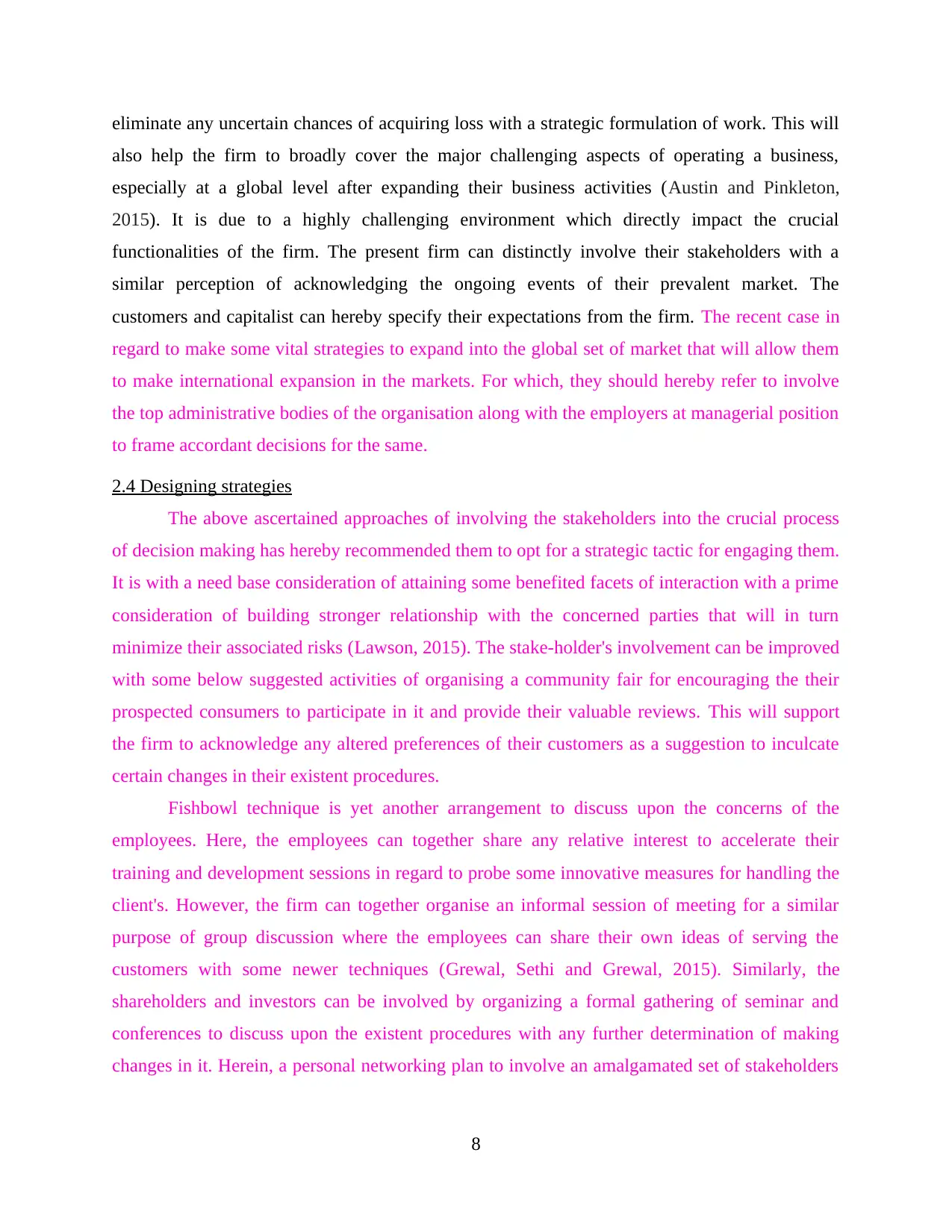
eliminate any uncertain chances of acquiring loss with a strategic formulation of work. This will
also help the firm to broadly cover the major challenging aspects of operating a business,
especially at a global level after expanding their business activities (Austin and Pinkleton,
2015). It is due to a highly challenging environment which directly impact the crucial
functionalities of the firm. The present firm can distinctly involve their stakeholders with a
similar perception of acknowledging the ongoing events of their prevalent market. The
customers and capitalist can hereby specify their expectations from the firm. The recent case in
regard to make some vital strategies to expand into the global set of market that will allow them
to make international expansion in the markets. For which, they should hereby refer to involve
the top administrative bodies of the organisation along with the employers at managerial position
to frame accordant decisions for the same.
2.4 Designing strategies
The above ascertained approaches of involving the stakeholders into the crucial process
of decision making has hereby recommended them to opt for a strategic tactic for engaging them.
It is with a need base consideration of attaining some benefited facets of interaction with a prime
consideration of building stronger relationship with the concerned parties that will in turn
minimize their associated risks (Lawson, 2015). The stake-holder's involvement can be improved
with some below suggested activities of organising a community fair for encouraging the their
prospected consumers to participate in it and provide their valuable reviews. This will support
the firm to acknowledge any altered preferences of their customers as a suggestion to inculcate
certain changes in their existent procedures.
Fishbowl technique is yet another arrangement to discuss upon the concerns of the
employees. Here, the employees can together share any relative interest to accelerate their
training and development sessions in regard to probe some innovative measures for handling the
client's. However, the firm can together organise an informal session of meeting for a similar
purpose of group discussion where the employees can share their own ideas of serving the
customers with some newer techniques (Grewal, Sethi and Grewal, 2015). Similarly, the
shareholders and investors can be involved by organizing a formal gathering of seminar and
conferences to discuss upon the existent procedures with any further determination of making
changes in it. Herein, a personal networking plan to involve an amalgamated set of stakeholders
8
also help the firm to broadly cover the major challenging aspects of operating a business,
especially at a global level after expanding their business activities (Austin and Pinkleton,
2015). It is due to a highly challenging environment which directly impact the crucial
functionalities of the firm. The present firm can distinctly involve their stakeholders with a
similar perception of acknowledging the ongoing events of their prevalent market. The
customers and capitalist can hereby specify their expectations from the firm. The recent case in
regard to make some vital strategies to expand into the global set of market that will allow them
to make international expansion in the markets. For which, they should hereby refer to involve
the top administrative bodies of the organisation along with the employers at managerial position
to frame accordant decisions for the same.
2.4 Designing strategies
The above ascertained approaches of involving the stakeholders into the crucial process
of decision making has hereby recommended them to opt for a strategic tactic for engaging them.
It is with a need base consideration of attaining some benefited facets of interaction with a prime
consideration of building stronger relationship with the concerned parties that will in turn
minimize their associated risks (Lawson, 2015). The stake-holder's involvement can be improved
with some below suggested activities of organising a community fair for encouraging the their
prospected consumers to participate in it and provide their valuable reviews. This will support
the firm to acknowledge any altered preferences of their customers as a suggestion to inculcate
certain changes in their existent procedures.
Fishbowl technique is yet another arrangement to discuss upon the concerns of the
employees. Here, the employees can together share any relative interest to accelerate their
training and development sessions in regard to probe some innovative measures for handling the
client's. However, the firm can together organise an informal session of meeting for a similar
purpose of group discussion where the employees can share their own ideas of serving the
customers with some newer techniques (Grewal, Sethi and Grewal, 2015). Similarly, the
shareholders and investors can be involved by organizing a formal gathering of seminar and
conferences to discuss upon the existent procedures with any further determination of making
changes in it. Herein, a personal networking plan to involve an amalgamated set of stakeholders
8
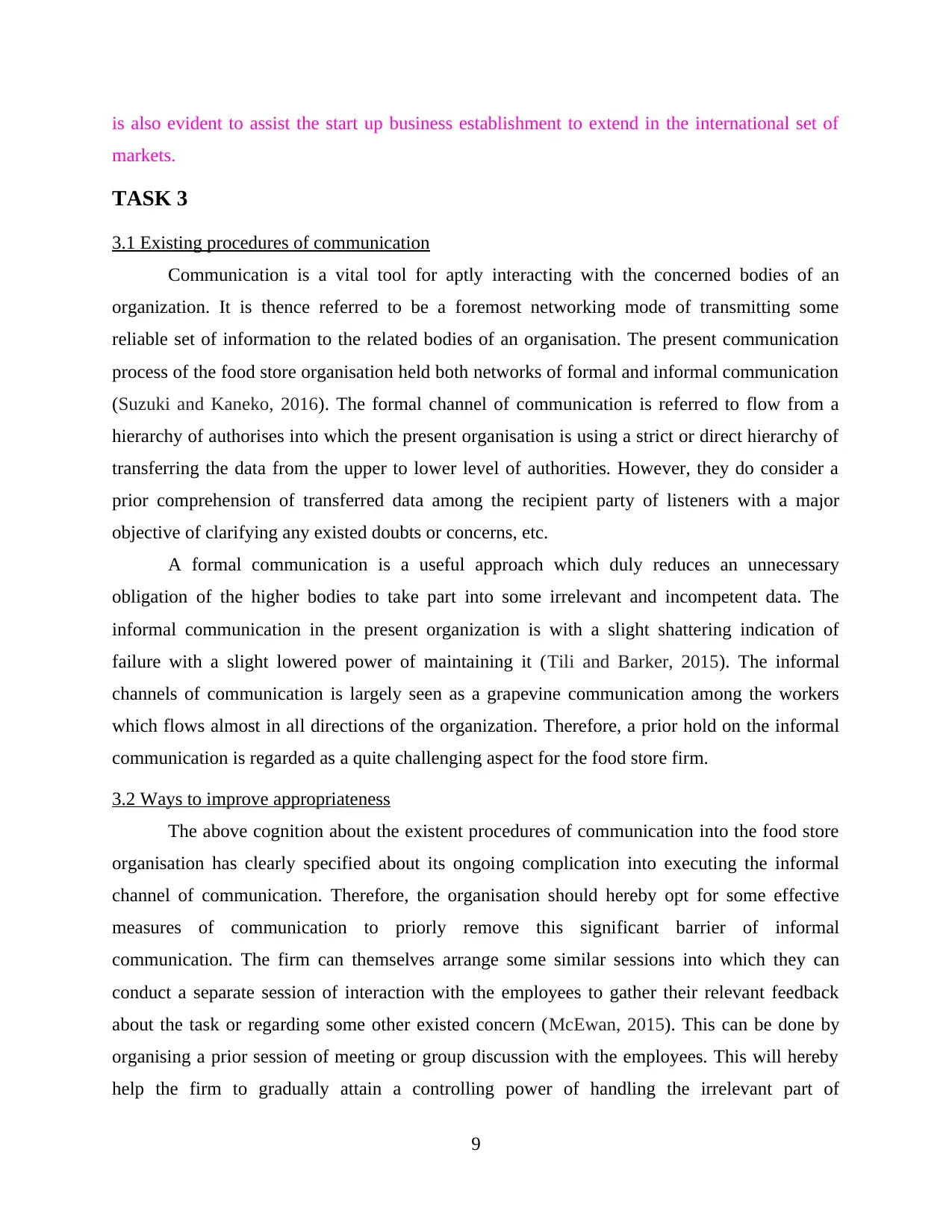
is also evident to assist the start up business establishment to extend in the international set of
markets.
TASK 3
3.1 Existing procedures of communication
Communication is a vital tool for aptly interacting with the concerned bodies of an
organization. It is thence referred to be a foremost networking mode of transmitting some
reliable set of information to the related bodies of an organisation. The present communication
process of the food store organisation held both networks of formal and informal communication
(Suzuki and Kaneko, 2016). The formal channel of communication is referred to flow from a
hierarchy of authorises into which the present organisation is using a strict or direct hierarchy of
transferring the data from the upper to lower level of authorities. However, they do consider a
prior comprehension of transferred data among the recipient party of listeners with a major
objective of clarifying any existed doubts or concerns, etc.
A formal communication is a useful approach which duly reduces an unnecessary
obligation of the higher bodies to take part into some irrelevant and incompetent data. The
informal communication in the present organization is with a slight shattering indication of
failure with a slight lowered power of maintaining it (Tili and Barker, 2015). The informal
channels of communication is largely seen as a grapevine communication among the workers
which flows almost in all directions of the organization. Therefore, a prior hold on the informal
communication is regarded as a quite challenging aspect for the food store firm.
3.2 Ways to improve appropriateness
The above cognition about the existent procedures of communication into the food store
organisation has clearly specified about its ongoing complication into executing the informal
channel of communication. Therefore, the organisation should hereby opt for some effective
measures of communication to priorly remove this significant barrier of informal
communication. The firm can themselves arrange some similar sessions into which they can
conduct a separate session of interaction with the employees to gather their relevant feedback
about the task or regarding some other existed concern (McEwan, 2015). This can be done by
organising a prior session of meeting or group discussion with the employees. This will hereby
help the firm to gradually attain a controlling power of handling the irrelevant part of
9
markets.
TASK 3
3.1 Existing procedures of communication
Communication is a vital tool for aptly interacting with the concerned bodies of an
organization. It is thence referred to be a foremost networking mode of transmitting some
reliable set of information to the related bodies of an organisation. The present communication
process of the food store organisation held both networks of formal and informal communication
(Suzuki and Kaneko, 2016). The formal channel of communication is referred to flow from a
hierarchy of authorises into which the present organisation is using a strict or direct hierarchy of
transferring the data from the upper to lower level of authorities. However, they do consider a
prior comprehension of transferred data among the recipient party of listeners with a major
objective of clarifying any existed doubts or concerns, etc.
A formal communication is a useful approach which duly reduces an unnecessary
obligation of the higher bodies to take part into some irrelevant and incompetent data. The
informal communication in the present organization is with a slight shattering indication of
failure with a slight lowered power of maintaining it (Tili and Barker, 2015). The informal
channels of communication is largely seen as a grapevine communication among the workers
which flows almost in all directions of the organization. Therefore, a prior hold on the informal
communication is regarded as a quite challenging aspect for the food store firm.
3.2 Ways to improve appropriateness
The above cognition about the existent procedures of communication into the food store
organisation has clearly specified about its ongoing complication into executing the informal
channel of communication. Therefore, the organisation should hereby opt for some effective
measures of communication to priorly remove this significant barrier of informal
communication. The firm can themselves arrange some similar sessions into which they can
conduct a separate session of interaction with the employees to gather their relevant feedback
about the task or regarding some other existed concern (McEwan, 2015). This can be done by
organising a prior session of meeting or group discussion with the employees. This will hereby
help the firm to gradually attain a controlling power of handling the irrelevant part of
9
⊘ This is a preview!⊘
Do you want full access?
Subscribe today to unlock all pages.

Trusted by 1+ million students worldwide
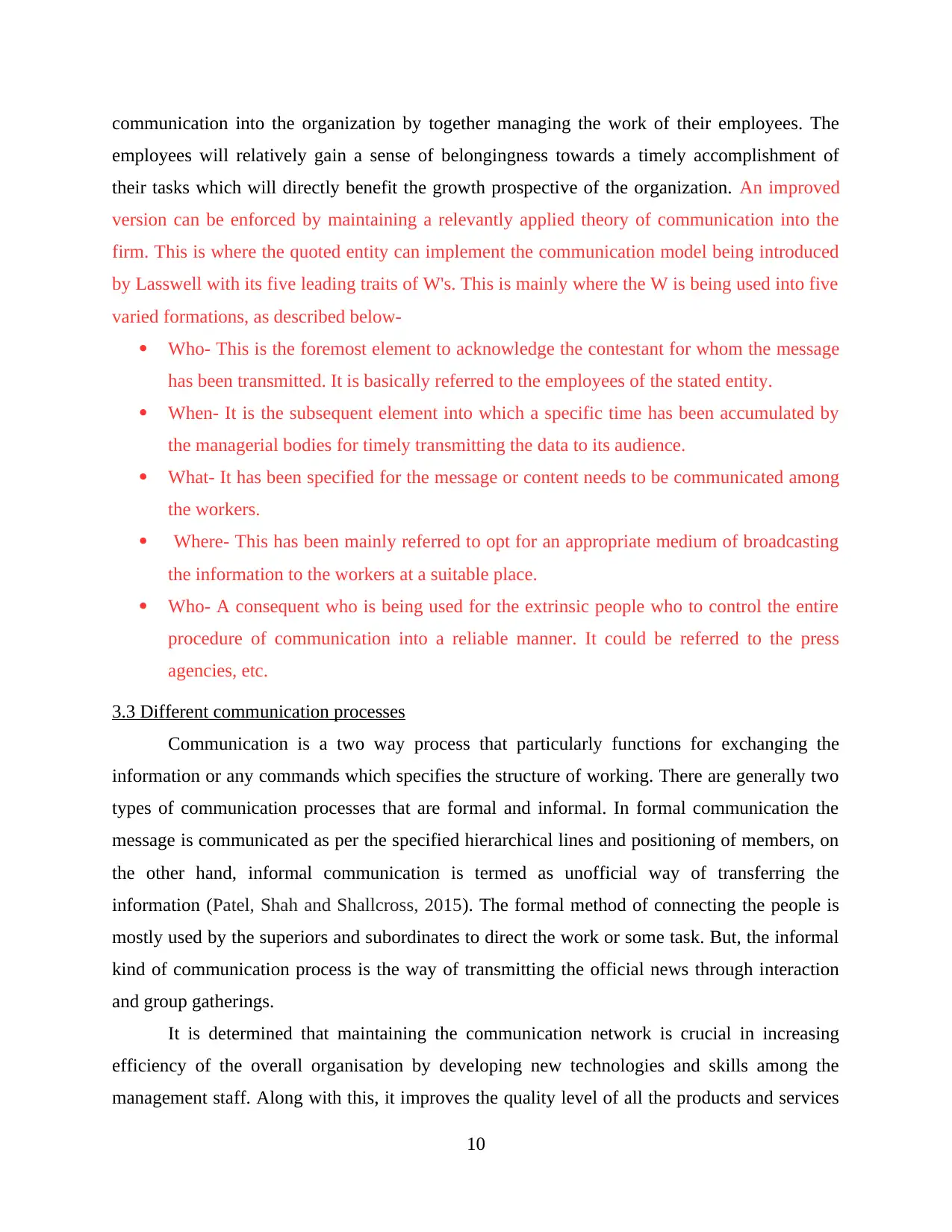
communication into the organization by together managing the work of their employees. The
employees will relatively gain a sense of belongingness towards a timely accomplishment of
their tasks which will directly benefit the growth prospective of the organization. An improved
version can be enforced by maintaining a relevantly applied theory of communication into the
firm. This is where the quoted entity can implement the communication model being introduced
by Lasswell with its five leading traits of W's. This is mainly where the W is being used into five
varied formations, as described below-
Who- This is the foremost element to acknowledge the contestant for whom the message
has been transmitted. It is basically referred to the employees of the stated entity.
When- It is the subsequent element into which a specific time has been accumulated by
the managerial bodies for timely transmitting the data to its audience.
What- It has been specified for the message or content needs to be communicated among
the workers.
Where- This has been mainly referred to opt for an appropriate medium of broadcasting
the information to the workers at a suitable place.
Who- A consequent who is being used for the extrinsic people who to control the entire
procedure of communication into a reliable manner. It could be referred to the press
agencies, etc.
3.3 Different communication processes
Communication is a two way process that particularly functions for exchanging the
information or any commands which specifies the structure of working. There are generally two
types of communication processes that are formal and informal. In formal communication the
message is communicated as per the specified hierarchical lines and positioning of members, on
the other hand, informal communication is termed as unofficial way of transferring the
information (Patel, Shah and Shallcross, 2015). The formal method of connecting the people is
mostly used by the superiors and subordinates to direct the work or some task. But, the informal
kind of communication process is the way of transmitting the official news through interaction
and group gatherings.
It is determined that maintaining the communication network is crucial in increasing
efficiency of the overall organisation by developing new technologies and skills among the
management staff. Along with this, it improves the quality level of all the products and services
10
employees will relatively gain a sense of belongingness towards a timely accomplishment of
their tasks which will directly benefit the growth prospective of the organization. An improved
version can be enforced by maintaining a relevantly applied theory of communication into the
firm. This is where the quoted entity can implement the communication model being introduced
by Lasswell with its five leading traits of W's. This is mainly where the W is being used into five
varied formations, as described below-
Who- This is the foremost element to acknowledge the contestant for whom the message
has been transmitted. It is basically referred to the employees of the stated entity.
When- It is the subsequent element into which a specific time has been accumulated by
the managerial bodies for timely transmitting the data to its audience.
What- It has been specified for the message or content needs to be communicated among
the workers.
Where- This has been mainly referred to opt for an appropriate medium of broadcasting
the information to the workers at a suitable place.
Who- A consequent who is being used for the extrinsic people who to control the entire
procedure of communication into a reliable manner. It could be referred to the press
agencies, etc.
3.3 Different communication processes
Communication is a two way process that particularly functions for exchanging the
information or any commands which specifies the structure of working. There are generally two
types of communication processes that are formal and informal. In formal communication the
message is communicated as per the specified hierarchical lines and positioning of members, on
the other hand, informal communication is termed as unofficial way of transferring the
information (Patel, Shah and Shallcross, 2015). The formal method of connecting the people is
mostly used by the superiors and subordinates to direct the work or some task. But, the informal
kind of communication process is the way of transmitting the official news through interaction
and group gatherings.
It is determined that maintaining the communication network is crucial in increasing
efficiency of the overall organisation by developing new technologies and skills among the
management staff. Along with this, it improves the quality level of all the products and services
10
Paraphrase This Document
Need a fresh take? Get an instant paraphrase of this document with our AI Paraphraser
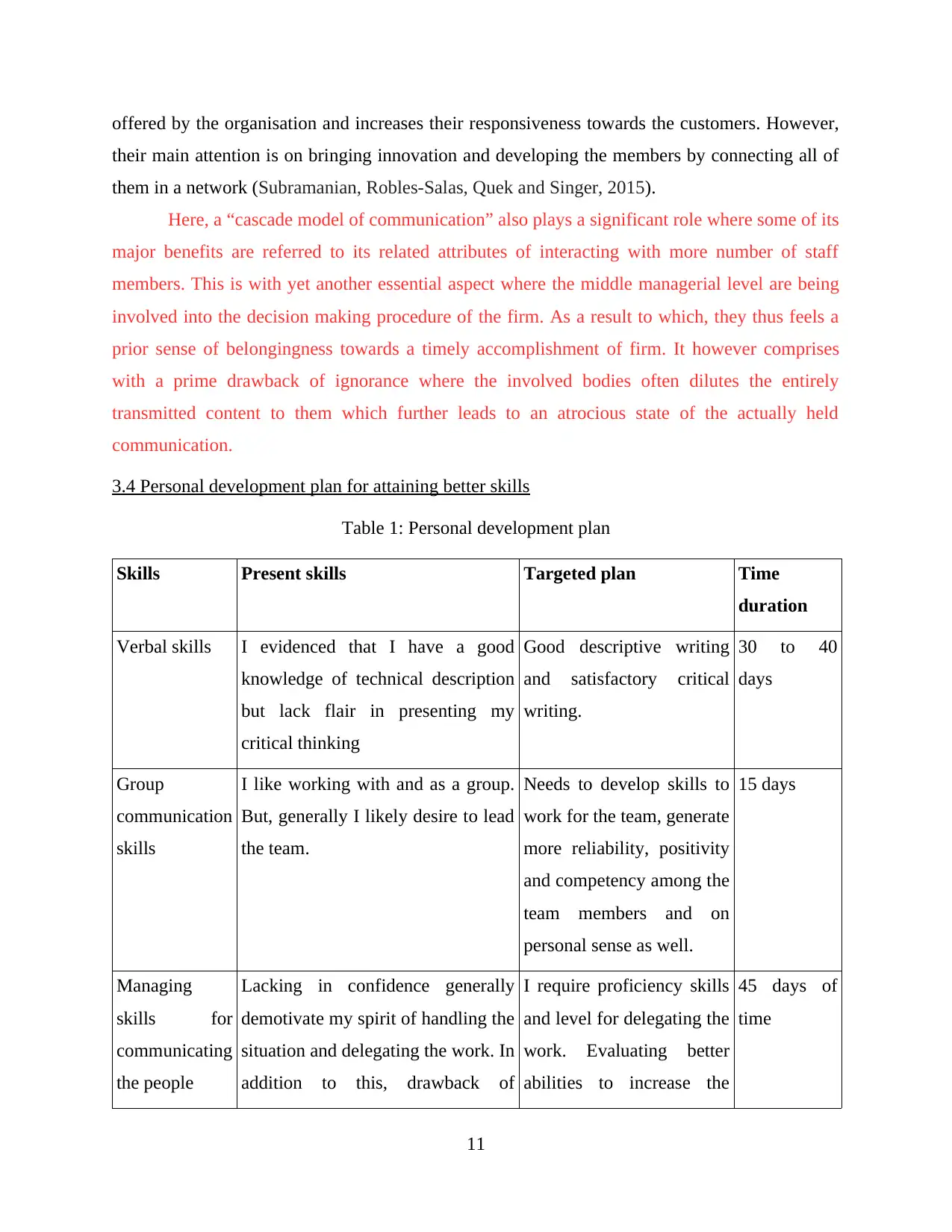
offered by the organisation and increases their responsiveness towards the customers. However,
their main attention is on bringing innovation and developing the members by connecting all of
them in a network (Subramanian, Robles-Salas, Quek and Singer, 2015).
Here, a “cascade model of communication” also plays a significant role where some of its
major benefits are referred to its related attributes of interacting with more number of staff
members. This is with yet another essential aspect where the middle managerial level are being
involved into the decision making procedure of the firm. As a result to which, they thus feels a
prior sense of belongingness towards a timely accomplishment of firm. It however comprises
with a prime drawback of ignorance where the involved bodies often dilutes the entirely
transmitted content to them which further leads to an atrocious state of the actually held
communication.
3.4 Personal development plan for attaining better skills
Table 1: Personal development plan
Skills Present skills Targeted plan Time
duration
Verbal skills I evidenced that I have a good
knowledge of technical description
but lack flair in presenting my
critical thinking
Good descriptive writing
and satisfactory critical
writing.
30 to 40
days
Group
communication
skills
I like working with and as a group.
But, generally I likely desire to lead
the team.
Needs to develop skills to
work for the team, generate
more reliability, positivity
and competency among the
team members and on
personal sense as well.
15 days
Managing
skills for
communicating
the people
Lacking in confidence generally
demotivate my spirit of handling the
situation and delegating the work. In
addition to this, drawback of
I require proficiency skills
and level for delegating the
work. Evaluating better
abilities to increase the
45 days of
time
11
their main attention is on bringing innovation and developing the members by connecting all of
them in a network (Subramanian, Robles-Salas, Quek and Singer, 2015).
Here, a “cascade model of communication” also plays a significant role where some of its
major benefits are referred to its related attributes of interacting with more number of staff
members. This is with yet another essential aspect where the middle managerial level are being
involved into the decision making procedure of the firm. As a result to which, they thus feels a
prior sense of belongingness towards a timely accomplishment of firm. It however comprises
with a prime drawback of ignorance where the involved bodies often dilutes the entirely
transmitted content to them which further leads to an atrocious state of the actually held
communication.
3.4 Personal development plan for attaining better skills
Table 1: Personal development plan
Skills Present skills Targeted plan Time
duration
Verbal skills I evidenced that I have a good
knowledge of technical description
but lack flair in presenting my
critical thinking
Good descriptive writing
and satisfactory critical
writing.
30 to 40
days
Group
communication
skills
I like working with and as a group.
But, generally I likely desire to lead
the team.
Needs to develop skills to
work for the team, generate
more reliability, positivity
and competency among the
team members and on
personal sense as well.
15 days
Managing
skills for
communicating
the people
Lacking in confidence generally
demotivate my spirit of handling the
situation and delegating the work. In
addition to this, drawback of
I require proficiency skills
and level for delegating the
work. Evaluating better
abilities to increase the
45 days of
time
11
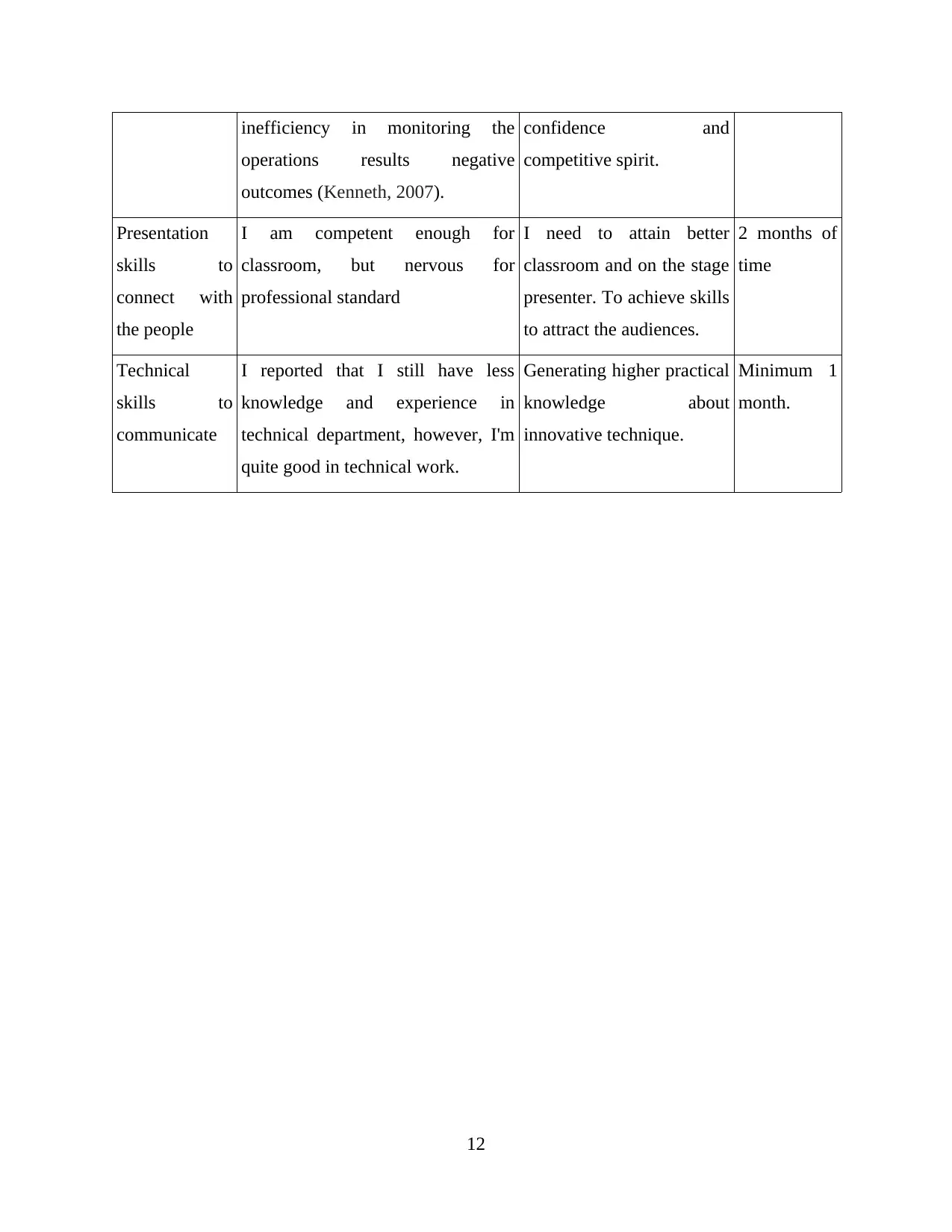
inefficiency in monitoring the
operations results negative
outcomes (Kenneth, 2007).
confidence and
competitive spirit.
Presentation
skills to
connect with
the people
I am competent enough for
classroom, but nervous for
professional standard
I need to attain better
classroom and on the stage
presenter. To achieve skills
to attract the audiences.
2 months of
time
Technical
skills to
communicate
I reported that I still have less
knowledge and experience in
technical department, however, I'm
quite good in technical work.
Generating higher practical
knowledge about
innovative technique.
Minimum 1
month.
12
operations results negative
outcomes (Kenneth, 2007).
confidence and
competitive spirit.
Presentation
skills to
connect with
the people
I am competent enough for
classroom, but nervous for
professional standard
I need to attain better
classroom and on the stage
presenter. To achieve skills
to attract the audiences.
2 months of
time
Technical
skills to
communicate
I reported that I still have less
knowledge and experience in
technical department, however, I'm
quite good in technical work.
Generating higher practical
knowledge about
innovative technique.
Minimum 1
month.
12
⊘ This is a preview!⊘
Do you want full access?
Subscribe today to unlock all pages.

Trusted by 1+ million students worldwide
1 out of 18
Related Documents
Your All-in-One AI-Powered Toolkit for Academic Success.
+13062052269
info@desklib.com
Available 24*7 on WhatsApp / Email
![[object Object]](/_next/static/media/star-bottom.7253800d.svg)
Unlock your academic potential
Copyright © 2020–2025 A2Z Services. All Rights Reserved. Developed and managed by ZUCOL.





